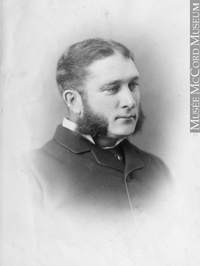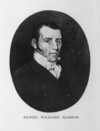
Source: Link
STIMSON, FREDERICK SMITH, farmer and rancher; b. 27 Nov. 1842 in Compton, Lower Canada, younger son of Arba Stimson and Mary Greely Smith; m. there 27 June 1866 his first cousin Mary Greely Smith, and they had a son; d. 15 Jan. 1912 in Montreal.
Arba Stimson was a prosperous merchant, farmer, and moneylender in Compton. When he died in 1863 his estate was worth about $100,000. Frederick Stimson was left a quarter interest and he took over the family farms. By 1871 he was one of the largest farmers in the district, with 1,000 acres, 124 cattle, and 23 horses. In addition he bought and sold land, loaned money, and served as captain of the Compton Volunteer Militia Troop of Cavalry.
In 1881, at the age of 39, Stimson chose to become a rancher. The 1870s had been a period of economic stagnation for the English-speaking farmers of the Eastern Townships. At the same time the growing market for beef cattle in Britain and a boom in American ranching presented opportunities to stockmen with capital. In Canada small-scale ranching began in the Rocky Mountain foothills in this decade. Stimson’s brother-in-law William Winder, for example, kept cattle near Fort Macleod (Alta) before he retired from the North-West Mounted Police in 1881 to take up ranching full time. That year, in a bid to control such development, to create a local supply of beef, and to encourage large-scale investment, the federal government implemented a policy of leasing extensive tracts for grazing. Stimson’s neighbour in Compton township and a leading stock breeder, Senator Matthew Henry Cochrane*, was a key figure in establishing this policy and a major investor in ranching.
In June 1881 Stimson took the first steps, in association with Sir Hugh* and Andrew* Allan of Montreal, to incorporate the North-West Cattle Company. Its authorized capital was $150,000; the Allans controlled 59 per cent of the initial issue of shares and Andrew Allan became president. Stimson, who held 19 per cent of the shares, became the company’s resident manager and went west in 1881 to select a range. In March 1882 the company was formally chartered. That same year Stimson bought more than 3,000 cattle in Idaho and had them driven to the company’s lease west of High River (Alta). An expert stockman but no cowboy, he hired experienced American cowboys such as George Lane* and John Ware* to handle day-to-day operations; Stimson himself focused on general management, sales and purchases, and relations with local officials and senior management. He also played a public role, becoming a territorial game guardian in 1884 and a justice of the peace in 1885. At the outbreak of the North-West rebellion he raised a company of scouts, known as Stimson’s Rangers, to patrol the Porcupine Hills.
Stimson’s ranch, centred on Pekisko Creek and known by its brand as the Bar U, avoided the mistakes of some of the other large ranches. The Cochrane Ranche, for example, lost at least 3,000 head of cattle in the winter of 1882–83, in part because it drove the cattle onto the range too late in the season and partly because, in accordance with orders from its eastern owners, it attempted to keep the cattle on its lease rather than let them drift to better pastures. The Bar U, which brought in cattle a month earlier than the Cochrane and allowed them to drift before the winter storms, suffered comparatively small losses.
By 1884 the Bar U was selling beef to the Department of Indian Affairs, the mounted police, and railway contractors. With the completion of the Canadian Pacific Railway, the market expanded to include British Columbia and Manitoba. In 1887 the Bar U and the Cochrane pioneered in shipping range cattle to the lucrative British market. Three years earlier the North-West Cattle Company had increased its authorized capital to $300,000 and in 1886 it merged with a neighbouring ranch, the Mount Head, and acquired its cattle and 44,000-acre lease. At the time the company’s books showed a profit of $133,204.25. By 1890 the Bar U was among the largest ranches in Canada, with 157,960 acres of leased land and 10,382 head of cattle. It is today a national historic site.
The government’s policy of grazing leases favoured large ranches and its implementation favoured those with political connections in Ottawa. Small ranchers and farmers who were in the country before the leases were issued, and who were prohibited from settling within them, bitterly resented the policy. With the arrival of more settlers, the government came under increasing pressure to abolish the system. As manager of one of the major leases, Stimson played a role in resisting this pressure. He served as a vice-president in 1883–86 of the ranchers’ lobby group, the South-Western Stock Association, and in 1892–93 of a similar group, the Stockmen’s Committee. He was one of the backers of the Calgary Herald and Alberta Livestock Journal, organized in 1888 to counter the pro-settlement editorials of the Macleod Gazette and Alberta Live Stock Record (Fort Macleod). Like most leaseholders, he supported the Conservatives. In 1895–96 he was president of the Calgary District Conservative Association; Liberals accused him of saying “he would fire every man he had that did not vote right” in the 1896 election.
The tide of settlement, however, was against the leaseholders. In 1892 they agreed to give up their leases in return for the right to purchase up to 10 per cent of the leased acreage and in some cases to negotiate limited leases. Equally important, the government agreed to prevent settlement on water-holes which were crucial to ranching operations. Under these terms the large ranches continued to operate successfully until the early 20th century. At Stimson’s urging the Bar U purchased about 18,000 acres of its lease. Although it had to reduce its operations, it still had over 3,000 cattle and 500 horses in 1902. The previous year Andrew Allan had died and in 1902 the Allan family accepted an offer of $220,000 for the ranch from George Lane and the Winnipeg meat-packing firm of Gordon, Ironside, and Fares [see Robert Ironside*]. Stimson, who was not consulted in the sale, believed the ranch had been undervalued and he went to court in an unsuccessful attempt to block the liquidation of the company.
In 1902 Stimson travelled to Cuba to look at investment prospects both for himself and for Sir William Cornelius Van Horne. Three years later he moved to Mexico, where he operated a large dairy-farm near Mexico City and acted as an agent for foreign investors. Because of ill health he returned to Canada in December 1911. He died the next month following an operation in the Montreal General Hospital and was buried in the Anglican cemetery in Compton.
In addition to playing a role in the development of the business of ranching, Frederick Stimson had made a contribution to the spirit of ranching. Mildly eccentric, with a reputation as a wit and a storyteller, Stimson was also gregarious and hospitable (in 1891 he was a founding member of the celebrated Ranchmen’s Club, the social headquarters for cattlemen visiting Calgary). These traits were as valued in ranching society as financial astuteness and managerial competence.
AC, Montréal, Cour supérieure, déclarations de sociétés, 23 mai 1902, no.46 (North West Cattle Company). ANQ-E, CE1-36, 23 nov. 1843. Canadian Pacific Arch. (Montreal), Van Horne corr., 68: Stimson to Van Horne, 27 Dec. 1907; Van Horne letter-books, 53: Van Horne to Stimson, 13 April 1902; Van Horne to Jekyll, 13 April 1902 (mfm. in NA, MG 29, A60). Mont. Hist. Soc. (Helena), T. C. Power papers, 166, file 6; 167, file 4. NA, RG 15, DII, 1, 698, files 345364-1–2; DV, 1, 1209, file 142709-1; 1211, file 145330-3; 1218, file 175296; 1220, file 192192; RG 95, vols.2571, 2616. PAA, Homestead files, 173491. Calgary Herald, 5 Feb. 1902. Gazette (Montreal), 16 Jan. 1912. Edward Brado, Cattle kingdom: early ranching in Alberta (Vancouver and Toronto, 1984). D. H. Breen, The Canadian prairie west and the ranching frontier, 1874–1924 (Toronto, 1983). Dominion annual reg., 1884–85. Alex Johnston, Cowboy politics: the Western Stock Growers’ Association and its predecessors (Calgary, 1971). Leaves from the medicine tree . . . (Lethbridge, Alta, 1960). D. [McN.] McEachran, Notes of a trip to Bow River, North-West Territories (Montreal, 1881). Norman Rankin, “The boss of the Bar U,” Canada Monthly (London, Ont.), 9 (1910–11): 323–33. J. P. Turner, The North-West Mounted Police, 1873–1893 . . . (2v., Ottawa, 1950), 2: 229.
© 1998–2024 University of Toronto/Université Laval
Image Gallery




Cite This Article
Alan B. McCullough, “STIMSON, FREDERICK SMITH,” in Dictionary of Canadian Biography, vol. 14, University of Toronto/Université Laval, 2003–, accessed April 23, 2024, http://www.biographi.ca/en/bio/stimson_frederick_smith_14E.html.
The citation above shows the format for footnotes and endnotes according to the Chicago manual of style (16th edition). Information to be used in other citation formats:
| Permalink: | http://www.biographi.ca/en/bio/stimson_frederick_smith_14E.html |
| Author of Article: | Alan B. McCullough |
| Title of Article: | STIMSON, FREDERICK SMITH |
| Publication Name: | Dictionary of Canadian Biography, vol. 14 |
| Publisher: | University of Toronto/Université Laval |
| Year of publication: | 1998 |
| Year of revision: | 1998 |
| Access Date: | April 23, 2024 |
















